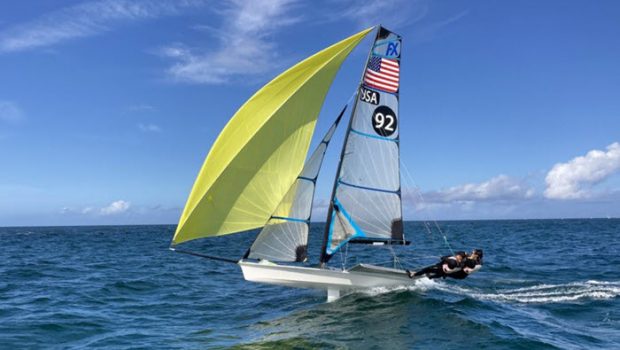Paris 2024: A different kind of flogging
Published on March 3rd, 2021
Beginning an Olympic campaign is broken down into four quarters, with the first quarter worried less about race results and more about learning the boat, and when the boat is the women’s 49erFX skiff, that’s a lot learning.
Lucy Wilmot and Erika Reineke, who are working toward Paris 2024, share the process of learning the art of flogging (and no, this doesn’t involve a whip or stick):
Known for its large and chaotic waves, Fort Lauderdale brought another dimension to our downwind skiff sailing.
Rounding the entrance to Port Everglades with reefs lining the north and south shore, waves reverberate off the jetties and stack up, creating steep peaks. Once clear of the shoal, there is a narrow runway before hitting the Gulf Stream to the east. We felt as if our tiny FX was thrown into a giant washing machine with so many multi-directional waves as soon as we exited the harbor.
Our goal in February was simple: conquer the waves.
With no obvious pattern to the swell, the sea-state wreaked havoc on our FX as we attempted to barrel through them. Steering downwind in steep and confusing ocean swell is similar to skiing down a mountain. In mogul skiing, it is crucial to find your line downhill before you embark on the descent. You must choose a viable path through each dip in the terrain, or you will risk colliding head-on into the next mogul.
The skiff hull design allows the boat to take flight over the crest of each wave easily. With a pointed bow, a flat stern, and wings, the boat beautifully bridges the gap between displacement and planing hulls. However, this feature can also be a limiting factor. How? It is possible to have too much speed.
Blasting downwind, the risk of stuffing the bow into the next wave is high. The solution to this problem is the kite flog.
The kite flog (releasing the sheet to luff it) is a skiff move that is gaining popularity in the FX class. It allows competitors to avoid a race-ending capsize. When the kite is flogged, the boat can track at a higher angle due to a temporary reduction of power in the sail.
Not only does the decrease in boat speed free the bow and lift it high in the air, but it also initiates leeward heel. An adequate leeward heel angle prevents water from rushing over the deck, thus slowing the boat ten-fold (as long as the wing doesn’t dip). Easing the kite momentarily and then wrangling it back in kills speed just enough to maneuver over a set of rogue waves.
Similar to skiing, we have to plan our downwind track with some foresight. Working together to visually read the wave period and height, we have to decide the fastest route to get over each set. Depending on each wave’s shape and mood, we can choose one of three options:
1) ride high over the face,
2) hold course, or
3) pivot down the leeward side.
The wrong choice can be fatal and potentially set us up for the “perfect pitchpole” when the bow drops into the trough. Through extensive practice in these conditions, we found the ultimate goal of flogging is to match the wave’s pace.
The crew eases the kite to get the hull flying at the same rate as the wave. The moment the boat and wave are moving in synchronicity, the crew trims the kite back on. As the crew trims, the skipper regains control of the boat’s pace on the backside of the wave. From there, the skipper can more easily find the next line as the boat builds up planing speed again.
Learning something new comes with lots of trial and error. Initially pitchpoles, ejections, and dragging behind the boat on the trap wires were evident. But after this month, downwinds started to feel like conquering a set of moguls.
There will always be variation and some unpredictability, but once you run the course a few times and get dialed with the texture of the mounds, you can make significant progress in controlling what others often deem uncontrollable.
We are blessed to get to tackle these skiffy wave demons head-on, and we can’t wait to start March off working with Brazilian skiff expert Carlos Robles. WHOOP WHOOP!
Team information: https://www.wilmotreinekefx.com









 We’ll keep your information safe.
We’ll keep your information safe.